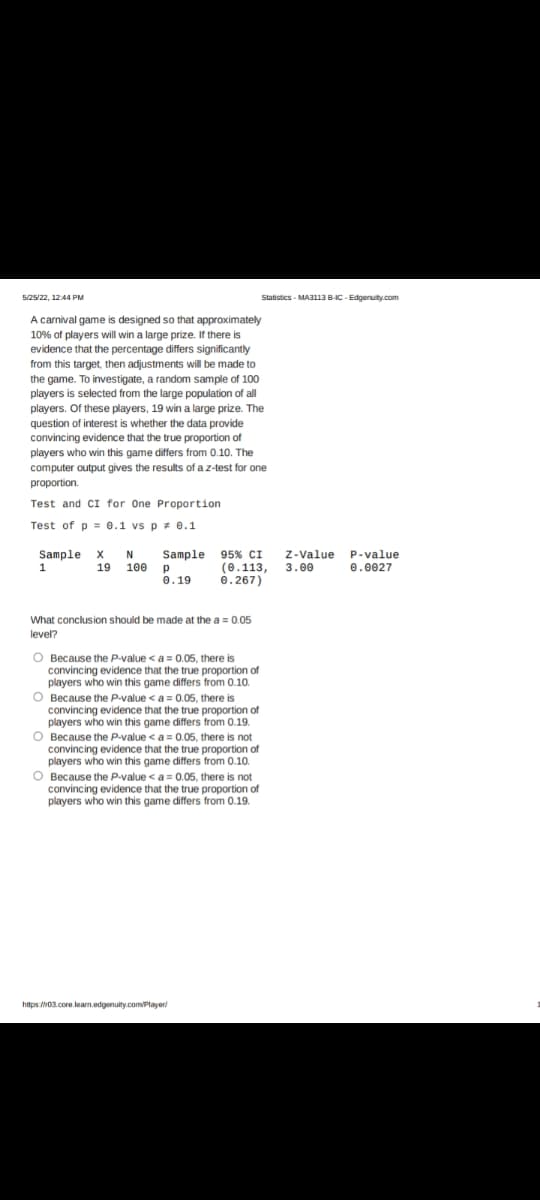A carnival game is designed so that approximately 10% of players will win a large prize. If there is evidence that the percentage differs significantly from this target, then adjustments will be made to the game. To investigate, a random sample of 100 players is selected from the large population of all players. Of these players, 19 win a large prize. The question of interest is whether the data provide convincing evidence that the true proportion of players who win this game differs from 0.10. The computer output gives the results of a z-test for one proportion. Test and CI for One Proportion Test of p = 0.1 vs p * 0.1 Sample X N Sample 1 19 100 Р 95% CI (0.113, 0.267) 0.19 What conclusion should be made at the a = 0.05 level? O Because the P-value < a= 0.05, there is convincing evidence that the true proportion of players who win this game differs from 0.10. Z-Value 3.00 P-value 0.0027
A carnival game is designed so that approximately 10% of players will win a large prize. If there is evidence that the percentage differs significantly from this target, then adjustments will be made to the game. To investigate, a random sample of 100 players is selected from the large population of all players. Of these players, 19 win a large prize. The question of interest is whether the data provide convincing evidence that the true proportion of players who win this game differs from 0.10. The computer output gives the results of a z-test for one proportion. Test and CI for One Proportion Test of p = 0.1 vs p * 0.1 Sample X N Sample 1 19 100 Р 95% CI (0.113, 0.267) 0.19 What conclusion should be made at the a = 0.05 level? O Because the P-value < a= 0.05, there is convincing evidence that the true proportion of players who win this game differs from 0.10. Z-Value 3.00 P-value 0.0027
Functions and Change: A Modeling Approach to College Algebra (MindTap Course List)
6th Edition
ISBN:9781337111348
Author:Bruce Crauder, Benny Evans, Alan Noell
Publisher:Bruce Crauder, Benny Evans, Alan Noell
Chapter5: A Survey Of Other Common Functions
Section5.6: Higher-degree Polynomials And Rational Functions
Problem 5E: Population Genetics In the study of population genetics, an important measure of inbreeding is the...
Related questions
Question

Transcribed Image Text:Statistics - MA3113 B-IC-Edgenuity.com
95% CI Z-Value P-value
(0.113, 3.00
0.267)
0.0027
5/25/22, 12:44 PM
A carnival game is designed so that approximately
10% of players will win a large prize. If there is
evidence that the percentage differs significantly
from this target, then adjustments will be made to
the game. To investigate, a random sample of 100
players is selected from the large population of all
players. Of these players, 19 win a large prize. The
question of interest is whether the data provide
convincing evidence that the true proportion of
players who win this game differs from 0.10. The
computer output gives the results of a z-test for one
proportion.
Test and CI for One Proportion
Test of p= 0.1 vs p = 0.1
Sample X N
Sample
1
19 100
Р
0.19
What conclusion should be made at the a = 0.05
level?
O Because the P-value < a = 0.05, there is
convincing evidence that the true proportion of
players who win this game differs from 0.10.
O Because the P-value < a = 0.05, there is
convincing evidence that the true proportion of
players who win this game differs from 0.19.
O Because the P-value <a = 0.05, there is not
convincing evidence that the true proportion of
players who win this game differs from 0.10.
O Because the P-value <a = 0.05, there is not
convincing evidence that the true proportion of
players who win this game differs from 0.19.
https://i03.core.learn.edgenuity.com/player/
Expert Solution
This question has been solved!
Explore an expertly crafted, step-by-step solution for a thorough understanding of key concepts.
Step by step
Solved in 3 steps

Recommended textbooks for you

Functions and Change: A Modeling Approach to Coll…
Algebra
ISBN:
9781337111348
Author:
Bruce Crauder, Benny Evans, Alan Noell
Publisher:
Cengage Learning

Linear Algebra: A Modern Introduction
Algebra
ISBN:
9781285463247
Author:
David Poole
Publisher:
Cengage Learning

Big Ideas Math A Bridge To Success Algebra 1: Stu…
Algebra
ISBN:
9781680331141
Author:
HOUGHTON MIFFLIN HARCOURT
Publisher:
Houghton Mifflin Harcourt

Functions and Change: A Modeling Approach to Coll…
Algebra
ISBN:
9781337111348
Author:
Bruce Crauder, Benny Evans, Alan Noell
Publisher:
Cengage Learning

Linear Algebra: A Modern Introduction
Algebra
ISBN:
9781285463247
Author:
David Poole
Publisher:
Cengage Learning

Big Ideas Math A Bridge To Success Algebra 1: Stu…
Algebra
ISBN:
9781680331141
Author:
HOUGHTON MIFFLIN HARCOURT
Publisher:
Houghton Mifflin Harcourt